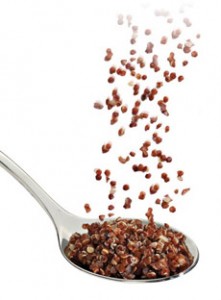TIP OF THE DAY: Roasted Peach & Chicken Salad
 Inspired feasting: grilled chicken salad with grilled peaches. Photo courtesy Good Eggs. |
There are so many ways to approach an entrée salad. This suggestion, from our favorite artisan grocer, Good Eggs of San Francisco, combines grilled proteins with grilled fruit. (They can be oven-roasted instead.) Good Eggs also suggests that instead of an all-green salad, you add whole grains for fiber, texture and flavor. Grilled or roasted, the season’s peaches add a wallop of sweet juiciness to a salad. If the peaches in your store aren’t great, you can substitute apricots, mangoes, pluots or nectarines (all are stone fruits like peaches; see details below). We happened to have some beautiful red rice from Lundberg on hand, and used it in our first version of this recipe (a hit!). RECIPE: GRILLED CHICKEN SALAD WITH PEACHES & Ingredients For 4 Servings arugula and watercress, or radishes) chopped |
|
|
For The Dressing |
||
|
Preparation 1. MAKE the yogurt dressing. Blend the ingredients and refrigerate to let the flavors meld. You can make this a day in advance. If the dressing is too thick at room temperature, thin it a tablespoon at a time with milk or plain kefir. 2. GRILL the chicken breasts and sliced peaches, or roast them at 400°F, for 20 minutes. You can grill the bread at the same time. When cool enough to work with, shred or julienne the chicken. 3. COOK the grains to al dente; you don’t want mushy grains with your crisp greens. While the grains are cooking, wash and pat dry the greens. 4. TOSS and plate the chicken, cooked grains, salad greens and herbs. Garnish with the peaches. Pass the yogurt dressing. Whole grains that are common in the U.S. include barley, buckwheat, bulghur, corn, oats, quinoa, rice (only colored rice, e.g. black, brown, red), rye, wild rice and whole wheat. |
 Read this if you need to be convinced of the benefits of whole grains. Photo of red quinoa courtesy Village Harvest. |
|
|
Whole grains that are less commonly used in the U.S. include amaranth, einkorn, farro/emmer wheat, freekeh, Kamut® Khorasan wheat, kañiwa (a cousin of quinoa), millet, sorghum, teff and triticale. Learn more about these grains at WholeGrainsCouncil.org. Stone fruits from the Rosaceae family are members of the Prunus genus, and include apricots, cherries, nectarines, olives, peaches, plums, and cherries and cross-breeds such as apriums, plumcots and pluots. A stone fruit, also called a drupe, is a fruit with a large, hard stone (pit) inside a fleshy fruit. The stone is often thought of as the the seed, but the seed is actually inside the stone. In fact, almonds, cashews, pecans and walnuts are examples of the seeds inside the stones. They’re also drupes, but a type in which we eat the seed inside the pit instead of the surrounding fruit. Not all drupes are stone fruits. The coconut is also a drupe, as are bramble fruits such as blackberries and raspberries. June through September is prime stone fruit season in the U.S. Enough botany for you? |
||


